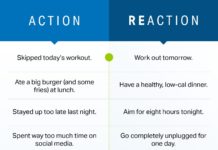
How This Nurse Lost 196 Pounds — and Regained Control of Her Life
Sitting in her doctor’s office two years ago, Molly Uttecht was ready to hear about the health risks of her excess weight. After all, as an emergency department nurse, she regularly saw people who faced weight-related diabetes and heart problems. What she didn’t expect was a diagnosis of mild arthritis that was likely to get worse.
“I’d just turned 29, so that was shocking,” she recalls. Heavy her whole life, Uttecht had never had any confidence issues in regard to her body, and she wasn’t interested in unsustainable yo-yo diets.
But then the hip pain began. At her job, she was constantly on her feet, checking on patients, lifting those who needed assistance and pushing gurneys. Every shift began to feel a little more difficult because of the shooting pain through her hips. When a doctor suggested physical therapy, Uttecht knew the stretching and mobility exercises he was suggesting weren’t going to be enough for her condition.
“I needed a change,” she says. “And that meant very large, very serious changes to how I was treating myself and my body. I didn’t want to be going into my 30s on lifelong arthritis or pain medication.”
She decided to start slow, with just two key changes in the first month: no fast food and no beer or soda. But what seemed like a minor shift became a major motivator when she stepped on the scale and saw she’d lost 35 pounds in just four weeks.
“When you start seeing results, that’s when you start thinking, ‘What else can I do?’” she says. “You want to take it to the next level to keep it going.”
For Uttecht, that meant food logging through MyFitnessPal, walking three times a week and joining a gym. She made sure to track all her calories, while staying off the fast food path. For exercise, she started with squats and crunches but increased her exercise routine as her hips began feeling better.
The results kept coming the more she tracked and worked out. By the third month, she’d lost 60 pounds, and seven months later, that total was up to 150. Now, nearly two years after that fateful doctor’s appointment, she’s 196 pounds lighter and jokes that those last four pounds to make it an even 200 seem to be the hardest to scrub away.
“But I’ll get there,” she says with a laugh. “I mean, come on. Four pounds!”
As the weight kept dropping, her activities kept expanding. Only a few months after joining the gym, she took a Zumba class and remembers being terrified. She was 330 pounds at that point and felt nervous about not being able to keep up. But she fell in love — and eventually became a Zumba teacher herself.
“I share my story a lot with my students because so many of them can relate,” she says. “I think it’s hard, as a heavy person, to take advice from someone who’s been thin all their lives or who’s never had emotional eating problems. But I can talk about how this isn’t just a physical change. Half the battle is the mental change you need to make.”
Uttecht also talks about the challenges that come with a transition from being about 400 pounds to someone half that weight. For example, she’s had to adjust to seeing herself as a smaller person.
“Early on, I would pick myself apart and still see that 400-pound woman in the mirror,” she recalls. “But then I’d see photos of myself and think I looked really small. It’s a weird adjustment that takes time.”
At this point, her hips no longer hurt and she’s planning on making Zumba teaching a bigger part of her life. She’s also scheduled to have surgery to address the excess skin on her arms, chest and tummy.
In terms of advice for others who are trying to follow a similar path, Uttecht says, “Don’t beat yourself up. Don’t forget to love yourself, but don’t make excuses, either. Hold yourself accountable. Log your food, know how many calories you’re eating every day. Put in the work, and you’ll see the results. And I promise, your body will switch over from being a source of exhaustion to being a source of amazing energy.”





